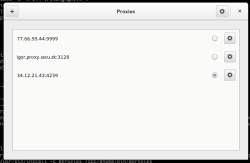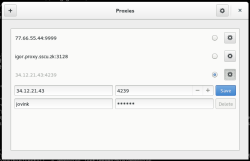Presenting GProxies
Lately, I’ve been working only from my laptop, and since I’m moving a lot usually I find myself in situations where I need to change networks details to properly connect to Internet. Now, GNOME and NetworkManager network configuration system does a decent job at remembering your network settings across different network.
The thing about this, it’s that a network profile as defined in System Settings does not keep your proxy configuration for that profile. So I took the task to wrote a small tool for keeping different proxy configurations and allowing easy switching between them.
The tool is called GProxies. It’s built using latest Gtk+, GLib and Vala. I tried to use the minimal amount of dependencies so it won’t have that much noise.
GProxies is designed with a very simple plugins system. Plugins are meant for
updating other applications’ configuration whenever you select a different proxy setting
from the interface. For instance: I made a plugin for updating my git’s http.proxy
config automatically when selecting a different a proxy settings. There are two types
of plugins: one main default plugin, for setting GNOME system settings’ proxy and
the others living inside ${XDG_DATA_DIR}/gproxies designed to update other applications
configuration.
A plugin is defined by a folder named after the plugin in ${XDG_DATA_DIR}/gproxies
with two or more files in it:
- a
plugin.inikey-file. More details are explained here. - an executable script/application which receives proxy details as calling arguments
This way you can make plugins for changing the proxy in any applications you want. I’ve made another repository with the plugins I’ve write for myself.
Right now the tool is in a working state. I have some other improvements in mind, such as:
- Add some interface to properly enable/disable plugins
- Add the ability to install plugins from zipped files or remote sources
- Add a direct-connection (no proxy enabled) state
Finally, I’d like to say how much I enjoyed coding a small application for the GNOME desktop. Gtk+ toolkit is perfect for this kind of task, with widgets which helps enforcing GNOME HIG making an application fits properly in the desktop environment. Also, Vala as a language it’s really powerful and composite widget templates from Gtk+ really speed up the development process. The code of GProxies is pretty simple, and I guess it would make a nice reading for GNOME developer beginners.
Below, I present some screenshots. I hope someone will find this useful.

